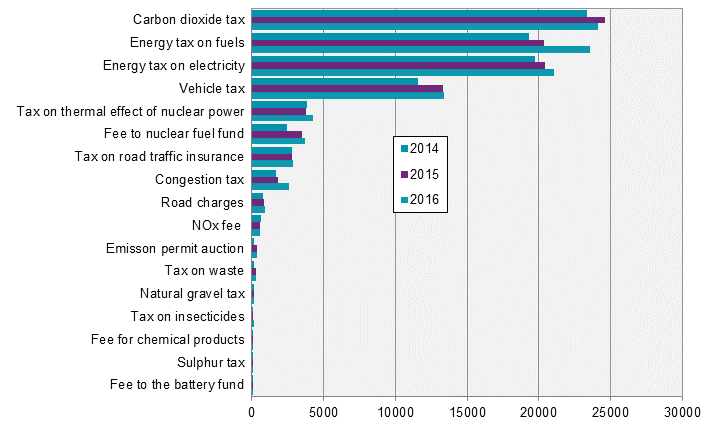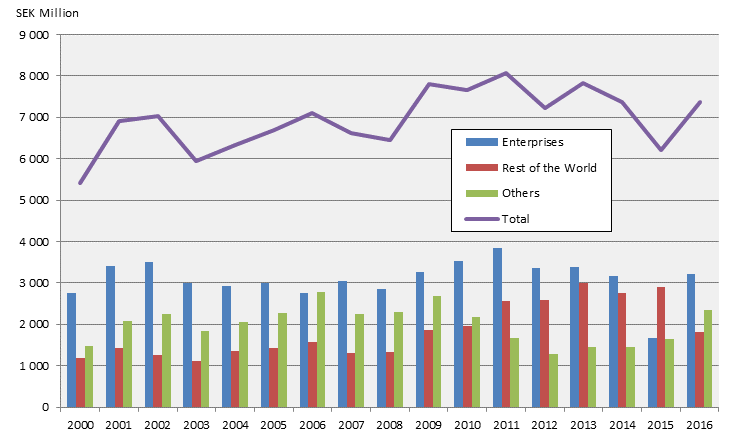Environmentally motivated subsidies and preliminary environmental tax revenue 2016:
Continued increase in environmental tax revenues
Statistical news from Statistics Sweden 2017-05-18 9.30
Environmental tax revenue in Sweden was SEK 98 billion in 2016. This is an increase of SEK 5 billion since 2015, but compared to other tax revenues, the environmental taxes’ share of the total tax revenues is decreasing marginally. This is the second year in a row that environmental tax revenue has reached an all-time high and it is mainly due to the increase in energy taxes. Environmentally motivated subsidies amounted to slightly less than SEK 7.4 billion in 2016. This is an increase of approximately 19 percent compared to 2015 but a return to pre-2015 levels.
Preliminary calculations of government revenue for 2016 show that about SEK 98 billion were paid in environmental taxes. That is the highest amount paid so far, with statistics on environmental taxes going back to 1993. It is the second year in a row that a new record level of environmental tax revenue has been reached, measured in current prices. Since 2014, environmental tax revenue has increased by approximately SEK 11 billion.
It is chiefly the revenue from energy taxes that has increased. Of these, the energy tax on fuels has increased the most, with SEK 3 billion. The total revenue from the fee to the nuclear fuel fund, the energy tax on electricity and the tax on the thermal effect of nuclear power has also increased by SEK 1.5 billion.
The revenue from the carbon dioxide tax decreased by almost SEK 0.5 billion in 2016. Since 2003, the carbon dioxide tax has accounted for the highest environmental tax revenue for the government. This remains true, but in 2016, the difference between the energy tax on fuels and the carbon dioxide tax was merely SEK 0.6 billion. In 2015, revenue from the carbon dioxide tax exceeded the energy tax on fuels by more than SEK 4 billion. Between 2015 and 2016, the tax exemptions on the carbon dioxide tax on diesel increased for among others the agriculture and forestry industries, which may partly explain the decrease in carbon dioxide tax revenues.
Other than energy taxes, revenue from the traffic congestion tax increased by SEK 0.7 billion after one of the major thoroughfare motorways in Stockholm, Essingeleden, was included in the tax. At the same time, the tax increased for the inner city of Stockholm, and a new higher maximum payment level was introduced. The total congestion tax revenues in 2016 for the cities of Gothenburg and Stockholm were approximately SEK 2.6 billion.

Environmental tax revenue as a share of total tax revenue
In 2016, just over 5.1 percent of all tax revenue in Sweden was attributable to environmental taxes. This is slightly below the level in 2015, which was 5.13 percent. Despite the SEK 5 billion increase in environmental tax revenue, the share did not increase, as other types of tax revenue increased more.
The share of environmental tax revenue out of total tax revenue is an indicator that can be compared among European countries. The most recent European statistics are from 2015, however. The EU 28 average was 6.1 percent at the time, and with 5.1 percent, Sweden has one of the lowest shares in Europe. Of the neighbouring countries, Denmark had the highest share at 8.4 percent of total tax revenue coming from environmental taxes.
Environmentally motivated subsidies
In 2016, environmentally motivated subsidies amounted to slightly less than SEK 7.4 billion. This is an increase of approximately 19 percent compared to 2015, but a return to the levels before 2015. Environmentally motivated subsidies include transactions that contribute to reduced climate- and environmental impact and an improved management of natural resources. Several areas are seeing an increase in subsidies. Within the agriculture sector, subsidies are increasing again after a reduction in 2015, and national support to climate initiatives and environmental research is also on the increase.
The subsidies, i.e. contributions from the state for investments and consumption, are given to different actors, both nationally and internationally. Subsidies to enterprises, non-profit organisations and other government agencies have increased substantially from 2015 and these recipients account for 75 percent of the total subsidies. The subsidies have mostly been for environmentally related improvements in agriculture and energy and environmentally related research for which Swedish enterprises have received support. Subsidies to the rest of the world, in the form of aid and international cooperation on the environment and climate, have decreased from SEK 2.9 billion in 2015 to SEK 1.8 billion in 2016.

Definitions and explanations
Environmental taxes
The definition of an environmental tax that is used by Statistics Sweden has been developed by Eurostat and the OECD. It is currently part of the global SEEA Central Framework statistical standards and makes comparative studies between different nations possible. The definition is:
"...it has been chosen to single out the tax base that seems to have a particular environmental relevance, and to consider all taxes levied on these tax bases as environmentally related regardless of motives behind their introduction, their names etc."
Consequently, according to the definition, it is the tax base that decides if a tax is environmental or not.
Statistics Sweden has presented statistics on environmental taxes since 1993.
Environmentally motivated subsidies
Environmentally motivated subsidies are defined according to the SEEA Central Framework statistical standards for environmental accounts. The definition that is used in the environmental accounts in Sweden is based on the motive behind the subsidy. Therefore the definition used in the environmental accounts is broader than the one used in the national accounts, i.e. the environmental accounts also include capital and current transfers and social benefits in kind.
To find the motive behind the subsidy, the primary source of information for the environmental accounts is the government’s budget propositions for different years. The statistics are derived from the National Financial Management Authority's calculations of the central government budget’s results where transactions are traced to the government appropriations from which they come. In 2015, Statistics Sweden carried out a development project that reviewed the methodology for the statistics
Statistics Sweden has presented statistics on environmentally motivated subsidies since 2000.
European statistics
European statistics can be found at Eurostat.
Feel free to use the facts from this statistical news but remember to state Source: Statistics Sweden.
